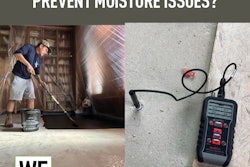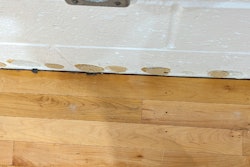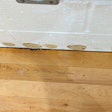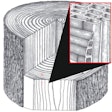Acclimation Anxiety
I installed a solid oak floor in a new house two months ago, and the customer just called and said there are big gaps between the boards. I acclimated the flooring in the house for three weeks—what went wrong?
Rusty Swindoll, assistant technical training director at the National Wood Flooring Association, answers:
Many contractors do not understand what "acclimation" means. It's a balancing act between the subfloor and the wood flooring, along with the home's living conditions. You need to know what the living conditions will be, what the normal moisture levels are for that area, and what the subfloor and flooring moisture readings are. So, acclimation isn't about how long the flooring sat on the job site before you installed it; it's more about the readings on your moisture meter.
The first thing you should do when the wood arrives on the job site is to check its moisture content (MC) with a moisture meter. Check the MC of the subfloor, too. For strip flooring, the readings should be within four points of each other. For plank, they should be within two points. In addition, both readings should be in the right range for that home once it's at normal living conditions. Say it's summer and you let the wood flooring sit at the job site for a few weeks before you install it, and the air conditioning isn't running. When you install, the floor's at 12 percent and the subfloor is at 10 percent. You think it's fine and install it. Then the customer moves into the house and turns on the air conditioning. Now you have abnormal gaps that may not go away (that sounds like what happened in this case).
If the installation is in an area with really big moisture swings, you don't want to acclimate your flooring to either extreme, even if it's normal during that season. It's best to shoot for a midpoint between the extreme moisture levels. Also, keep in mind that some species are more stable than others, and many manufacturers of engineered floors do not recommend any acclimation at all (always follow the directions from the manufacturer).
AC and RH
Does air conditioning control relative humidity?
Neil Moss, now retired from his position as director of technical services for Lancaster, Pa.-based Armstrong Floor Products, answers:
Air conditioning should assist in controlling relative humidity (RH). Unfortunately, in many cases, homes are over-air-conditioned, using far more "tonnage" than needed. The usual reason for this is the HVAC contractor's belief that larger units cool the home faster, then shut down after a shorter time, thus conserving energy—which they do. This is especially true with new homes, which have much tighter construction than in the past and also have high efficiency A/C systems. Consequently, modern A/C units need to stay on for a far shorter period of time than older units do.
This is great for conserving energy, but it reduces the capability of removing moisture. The result is cooler air with higher humidity. In some cases, RH can actually increase with the A/C on because when air is cooled without the removal of moisture, the RH will increase, hence t he phrase "relative humidity"—the relationship of moisture to temperature. In many cases, even with air conditioning in the home, a dehumidification system is also necessary to maintain a consistent RH range and a healthy environment for a wood floor.
Sanding Engineered Floors
When remodeling, customers often want to refurbish their engineered wood floors to change the color or to eliminate scratches and gouges. What is the rule of thumb for the number of times engineered floors can be resanded without causing damage?
Greg Burleson, manager of sourced products at Johnson City, Tenn.-based Mullican Flooring, answers:
First, let me point out that most engineered wood floors that have simply dulled over time or have lost their sheen can be recoated many times throughout their life spans. Recoating is much less invasive than sanding and can be done either mechanically or chemically. Both of these approaches also can be used on sculpted surfaces.
However, to change overall color or to remove scratches or stains that have gone all the way through the finish, engineered wood floors do require sanding, which demands caution and investigation. Top layer thickness, subfloor flatness and edge or bevel treatment of the floor need to be considered. The best method to check a floor's remaining wear layer is to remove a vent so you have a side view of the flooring.
If the floor has a beveled edge, the sanding must remove this bevel and the stain and finish on the bevel. It is at this point that one must know the floor's top layer thickness. In many cases, once the bevel is removed, there isn't enough wood top layer left to provide a serviceable floor covering, so recoating may be the only option.
Modern finishes on today's wood floors make general upkeep extremely easy and, if caution is applied, can delay the need for time-consuming recoating, repairing and resanding. Remind customers about the following day-to-day maintenance:
- Immediately wipe up any spills or spots.
- Vacuum or sweep at least every other week.
- Clean the floor at least monthly with a wood floor cleaner recommended by the floor manufacturer (never wet-mop).
- Protect the wood floor in high traffic areas by using area rugs. Put mats at all entrances to keep dirt and moisture off the floor.
- Use floor protectors on furniture legs.
- Protect the floor when moving heavy furniture or appliances.
- Watch out for high heel shoes and small stones lodged in shoes.
- Block excessive sunlight with blinds or drapes.
- Find out about the humidity levels in your area and how to keep the wood from shrinking or expanding too much. Never shut off your HVAC system for long periods of time, such as during summer vacations.
































